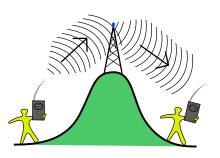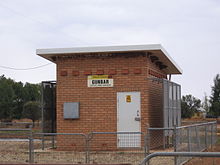Repeater
A repeater (English literally for "repeater"), also called regenerator , is an electrical or optical signal amplifier or conditioner in communication technology to increase the range of a signal. The repeater is located some distance from the transmitter, receives its signals and sends them on in a processed form, which means that a greater distance can be bridged.
When using digital transmission methods, the signal can also be decoded by the repeater, which removes signal interference (such as noise or distortion of the pulse shape ). The signal is then re-encoded, modulated and sent on.
The transmitted information is not influenced by simple repeaters, only the electrical or optical signal is processed. In contrast, more sophisticated digital repeaters can match the signal z. B. add an identifier that enables the traceability of the signal path if there are several possible paths.
Overview
As a signal traverses a communication channel, it is gradually degraded due to degradation in performance . For example, when a phone call is made over a telephone line, some of the power is dissipated as heat. The longer the wire, the more power is lost and the smaller the amplitude of the signal at the other end. If the line is long enough, the call cannot be heard at the other end. The further away a receiver is from a radio station, the weaker the radio signal and the worse the reception. A repeater is an electronic device on a communication channel that increases the power of a signal and retransmits it so it can travel further. As it amplifies the signal, it requires a source of electrical energy.
The term "repeater" originated in 19th century telegraphy and referred to an electromechanical device (a relay) used to regenerate telegraph signals. The use of the term has continued in telephony and data communications.
Types
Repeaters can be divided into two types depending on the type of data they are processing
Analog repeater
This type is used in channels that carry data in the form of an analog signal where the voltage or current is proportional to the amplitude of the signal, like an audio signal. They are also used in trunklines that carry multiple signals using frequency division multiplexing (FDM). Analog repeaters consist of a linear amplifier and can contain electronic filters to compensate for frequency and phase distortions in the line.
Digital repeater
The digital repeater is used in channels that carry data by binary digital signals, the data being in the form of pulses with only two possible values representing the binary digits 1 and 0; a digital repeater amplifies the signal and can also retiming, resynchronizing and shaping the impulses . A repeater that performs the retiming or resynchronization functions can be called a regenerator .
Repeater in computer technology
In computer networks, repeaters are part of the bit transmission layer (layer 1 of the OSI model ) to expand network segments.
Transceivers and star couplers are special variants of repeaters . A repeater with more than two connections is also known as a hub or multi-port repeater. A media converter can also be viewed as a repeater as long as it does not contain a bridge function.
Repeater in network technology
The use of repeaters lends itself to z. B. in LANs in bus topology to the maximum cable length of z. B. to expand 185 m with 10BASE2 . The repeater divides the network into two physical segments, but the logical bus topology is retained. As a result of this effect, the repeater increases the reliability of the network, since if one sub-network fails, the other can continue to act independently. In a "normal" bus topology, the entire network would fail. Repeaters do not increase the available data rate of a network.
There are two types of repeaters in LAN technology:
- Local repeaters that connect two local network segments with each other, and
- Remote repeaters that connect two physically separate network segments via a so-called link segment . A link segment consists of two repeaters that are interconnected by fiber optic cables. This means that larger distances can be bridged.
Repeaters can not be cascaded arbitrarily in an Ethernet . Since segments connected with repeaters form a collision domain , two stations may only be far enough apart due to the delay times of the signal that the collision detection still clearly functions. This is done with the 5-4-3 rule .
Repeater in fiber optic technology
In optical submarine cables ( submarine cables ), the light is amplified every 50 to 80 km with optical amplifiers built into the cable on the seabed. In addition, optical repeaters are required at greater intervals (approx. Every 500 to 1000 km) in order to regenerate the steepness of the edge of the light pulses and to compensate for any time delays. The optical amplifiers and repeaters are supplied with electrical energy through the copper sheath of the cable.
WiFi repeater
In information technology, WLAN repeaters can be used to increase the range of a wireless radio network. When using a repeater, however, the data transmission rate of the wireless network behind the device is halved , as the repeater communicates with both the clients and the wireless access point . Halving the data rate can be avoided in that the communication between client and repeater takes place on a different frequency than that between repeater and router. This option is usually not built into commercially available repeaters. With a wireless connection through several walls or over longer distances, a WLAN repeater can be used to achieve better transmission quality and thus speed.
Almost all modern, commercially available wireless access points offer a repeater mode in order to provide larger buildings, properties and sites with sufficient network coverage. Using roaming , clients can move freely in the entire coverage area of the network without the data traffic being impaired by disconnections.
In theory, up to 254 WLAN repeaters can be operated in one network. In practice, the repeaters should not be connected in series, but rather in a star configuration, as radio signal overlaps occur from as little as 20 repeaters.
Repeater in the telecommunications network
Repeater in telecommunications networks (for example, for SHDSL / G.SHDSL , HDSL and E1 / Primary Rate Interface ) are predominantly as repeaters designated (ZWR). Areas of application are both copper and fiber optic transmission. However, the basic structure of the ZWR is identical for both areas of application:
Usually there is a central inverter from an NT (Network Termination, network termination ) and LT (Line Termination, line termination ) that "back-to-back" are interconnected (ger .: "Back-to-back"). The NT terminates the incoming transmission path (e.g. SHDSL) and decodes the digital values. The LT receives the digital values through fixed wiring and encodes them into a new SHDSL signal. For this, however, this ZWR requires an additional power supply (remote feed), which can be switched on from the main distributor or (especially in the case of routes with a second ZWR) from the customer's NT.

Repeater in (mobile) radio networks
In the mobile communications sector, repeaters are used as relay stations for "illuminating" shaded areas, e.g. B. buildings or subways are used. Intrain repeaters are used in trains .
Radio network repeaters for cell phone networks ( GSM , UMTS , Tetrapol ) are mainly used as two-way amplifiers (uplink and downlink) to enlarge a cell phone and enable reception in buildings, garages, tunnels and ships. As well as regenerating the signal quality, more intelligent repeaters can re- synchronize the electrical signal , as with repeaters that are used in the direct call network of Deutsche Telekom .
Repeater in amateur radio
Repeaters also play a role in amateur radio services . In German-speaking countries they are called relay stations . Repeaters for digital operating modes are called digipeaters .
See also
Web links
Individual evidence
- ^ AE Loring: A Hand-book of the Electromagnetic Telegraph . D. Van Nostrand, 1878, p. 53 (English, limited preview in Google Book search).
- ^ First Antennas For Relay Stations. (PDF) Retrieved on May 21, 2019 (English).
- ↑ TechTarget: Repeater. Retrieved May 21, 2019 .
- ↑ a b Electronics Compendium: Repeater. Retrieved May 21, 2019 .
- ↑ What is a fiber-optic repeater? Retrieved May 21, 2019 .
- ↑ SignalBoost.de. June 17, 2015, accessed June 17, 2015 .
- ^ ISDN - The new telecommunications network of the Deutsche Bundespost Telekom, R. v. Decker's Taschenbuch Telekommunikation, 4th revised and expanded edition, 1992, p. 17




